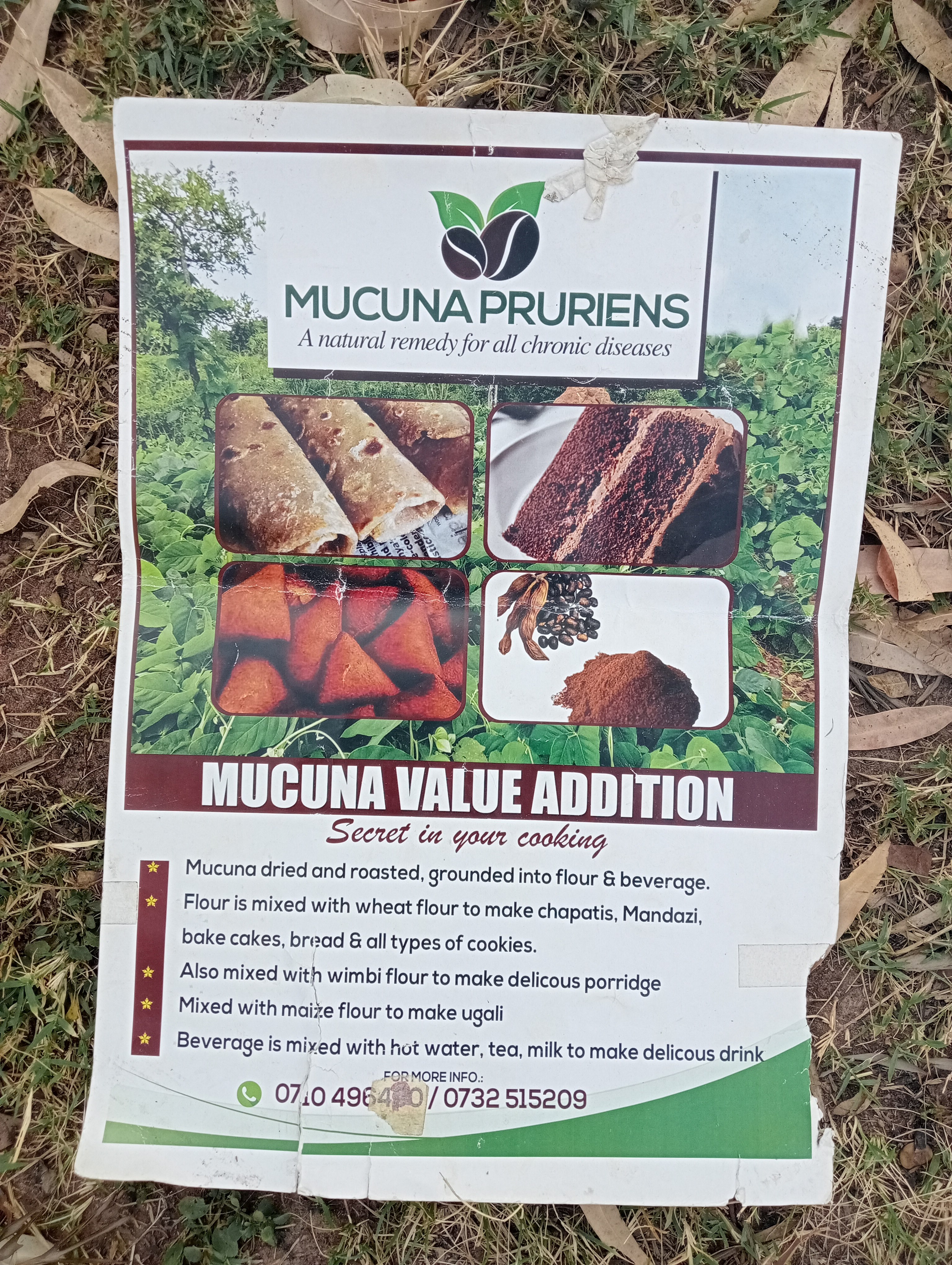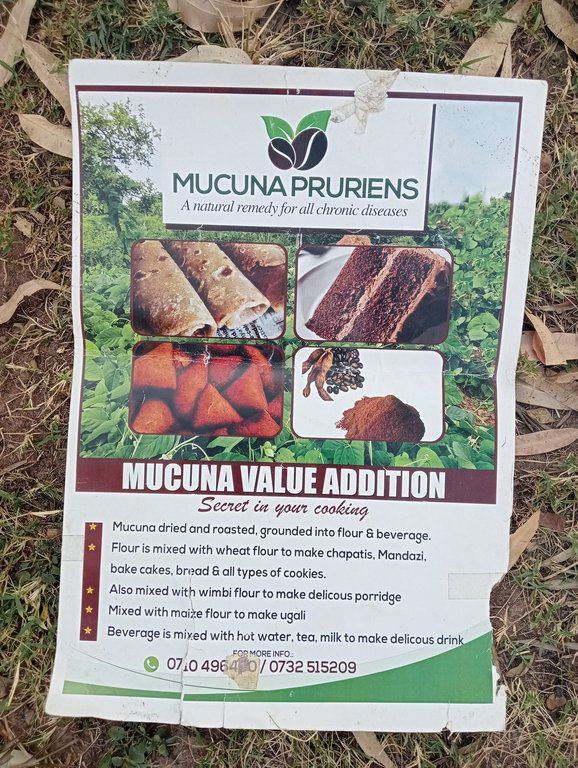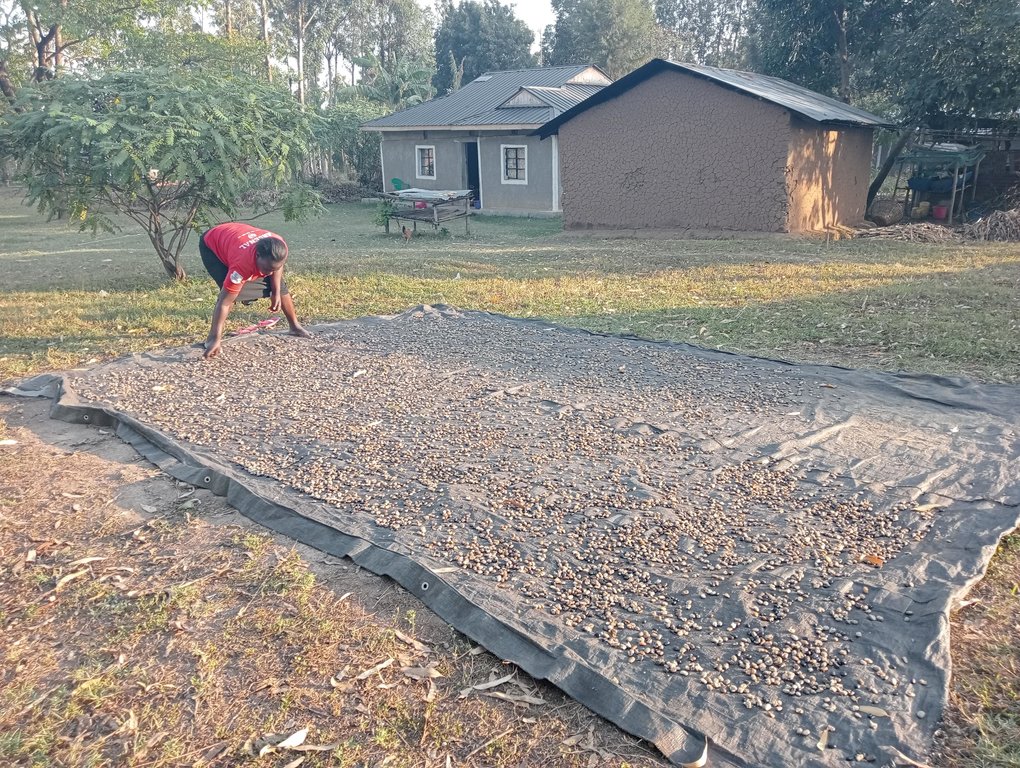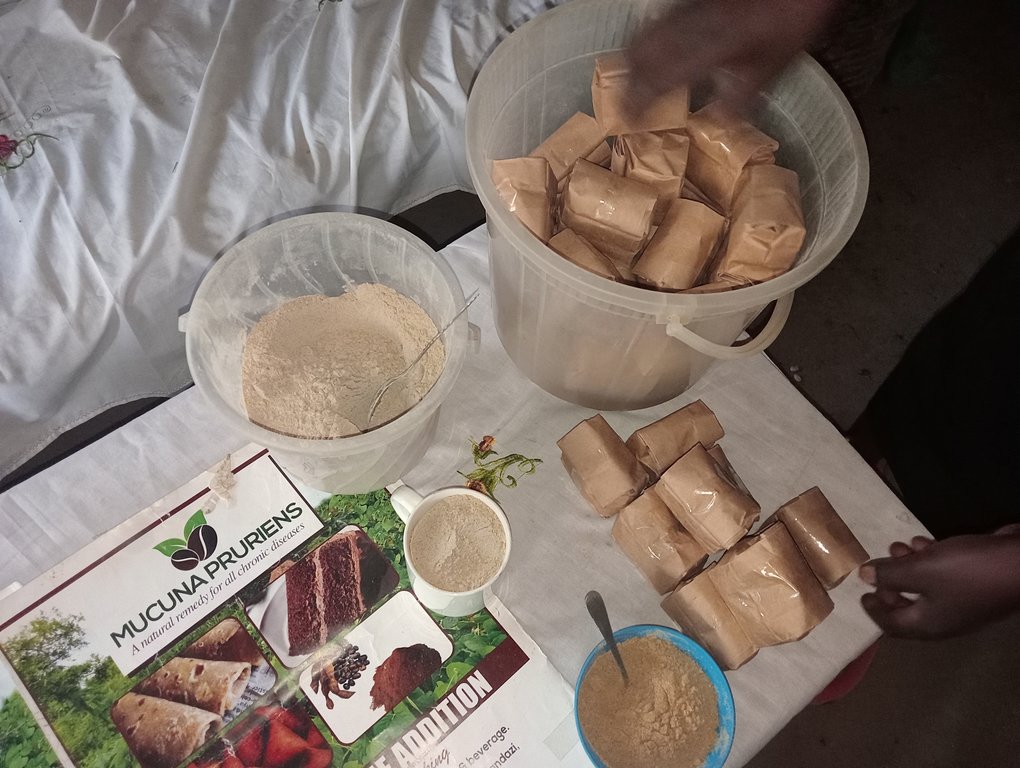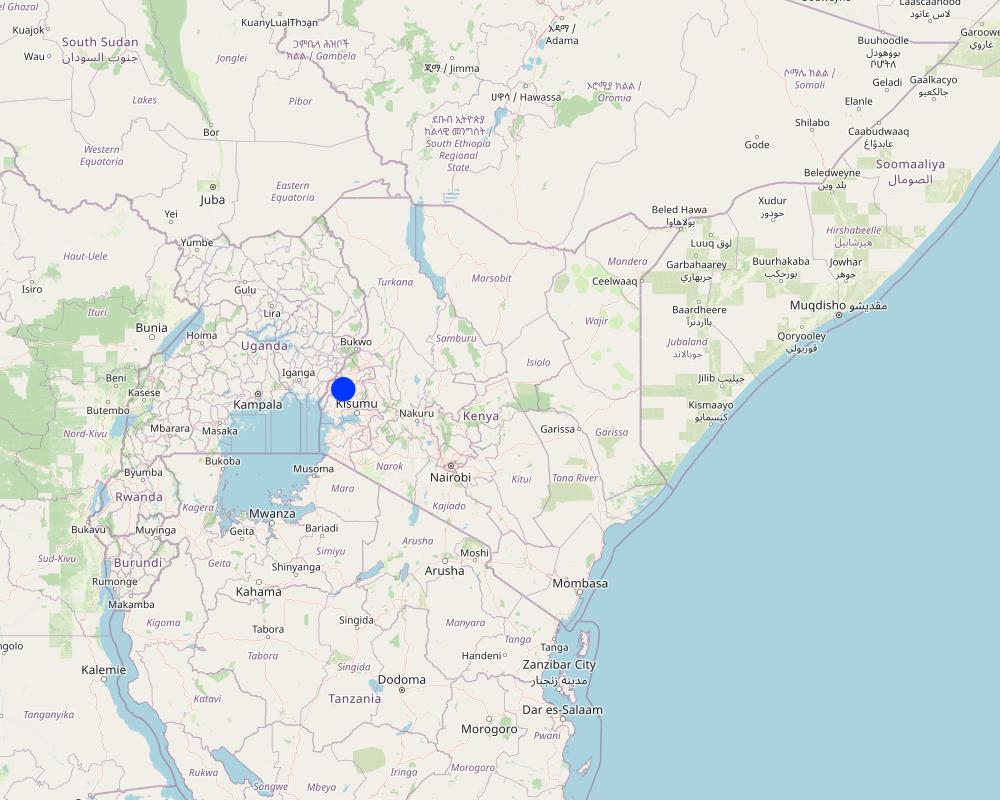Mucuna value-addition for female farmers [肯尼亚]
- 创建:
- 更新:
- 编制者: William Akwanyi
- 编辑者: George Onyango, Innocent Faith, Noel Templer, Tabitha Nekesa, Ahmadou Gaye, Siagbé Golli
- 审查者: William Critchley, Rima Mekdaschi Studer, Sally Bunning
N/A
approaches_6684 - 肯尼亚
查看章节
全部展开 全部收起1. 一般信息
1.2 参与方法评估和文件编制的资源人员和机构的联系方式
关键资源人员
土地使用者:
Asievela Rebecca
+254 714 890016 / +254 731 265120
rebecca.asievela@gmail.com / N/A
Welthungerhilfe farmer
Rebecca Asievela's farm in Emachina Village, Koyonzo Ward, Matungu Sub-county, Kakamega County
肯尼亚
SLM专业人员:
SLM专业人员:
有助于对方法进行记录/评估的项目名称(如相关)
Soil protection and rehabilitation for food security (ProSo(i)l)有助于对方法进行记录/评估的机构名称(如相关)
Deutsche Gesellschaft für Internationale Zusammenarbeit (GIZ)有助于对方法进行记录/评估的机构名称(如相关)
CIAT International Center for Tropical Agriculture (CIAT International Center for Tropical Agriculture) - 肯尼亚1.3 关于使用通过WOCAT记录的数据的条件
(现场)数据是什么时候汇编的?:
28/01/2023
编制者和关键资源人员接受有关使用通过WOCAT记录数据的条件。:
是
1.4 SLM技术问卷的参考
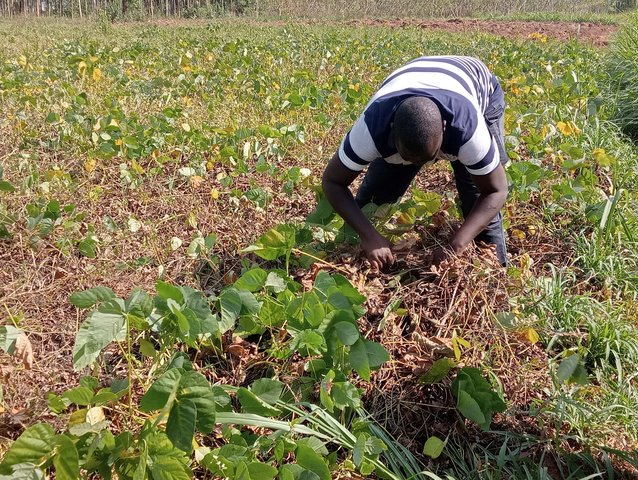
Permanent soil cover [肯尼亚]
Permanent soil cover with cover crops and/or crop residues helps to control soil erosion, suppress weeds and build up soil fertility. It can also add organic matter to the soil.
- 编制者: William Akwanyi
2. SLM方法的描述
2.1 该方法的简要说明
Promoting mucuna seed processing for food and nutrition security and income generation encourages women farmers to plant mucuna as a cover crop that improves soil productivity.
2.2 该方法的详细说明
该方法的详细说明:
Mucuna pruriens (velvet bean) is tropical legume that is widely known for its ability to rehabilitate soils by increasing organic matter. Unlike many other legumes of the bean family, mucuna seeds (beans) are not very palatable. In addition, raw and unprepared mucuna beans can cause severe digestive disorders. However, due to its emerging health and economic benefits, many farmers are now adopting the crop. Consequently, the crop is simultaneously helping in soil conservation by controlling soil erosion and improving soil structure alongside suppressing weeds.
Promoting the economic benefits of mucuna through value addition is a key factor in ensuring farmers adopt mucuna as a conservation agriculture crop. Mucuna value addition involves various stages of beans preparation/ treatment aimed at reducing the potential of L-DOPA toxicity. The ProSoil project promoted the uptake of mucuna as a green manure cover crop by training farmers on mucuna bean value-addition. In Matungu area of Kakamega County, Kenya, the ProSoil project partnered with a local farmer-based self-help group, Tunza Udongo Self Help Group [‘tunza udongo’ is a Kiswahili phrase for ‘take care of the soil’] which facilitated the convening women farmers. The project facilitated specialists in mucuna value addition from the Ministry of Agriculture who trained the farmers.
To spread this approach, the trained farmers train other farmers. In addition to the training in mucuna value-addition, the farmers were informed about the ecological and economic importance of mucuna and its propagation. The ProSoil project (GIZ and WHH) and Ministry of Agriculture invite the farmers to events such as farmer field days where they can exhibit different products from mucuna, network, and link up with potential markets. On the other hand, Tunza Udongo Self Help plays an important role in collective marketing.
One aim of promoting mucuna value addition is to increase its uptake by farmers as a green manure cover crop which is an important measure in conservation agriculture. Mucuna beans preparation is a domestic chore equivalent to other chores that are traditionally performed by women. Consequently, the entire farming household benefits from the income from the sale of mucuna products (skin free beans, flour, beverage, and baked products). The prices of these products vary in time and space depending on the availability of and demand for the products. However, the average prices are KES 100.00 per kg of skin free beans, KES 120.00 per kg of flour, and KES 150.00 per kg of beverage. Farmers also sell unprocessed mucuna beans as seed at KES 100.00 – 200.00 per kg depending on the availability of, and demand for, the seeds.
2.3 该方法的照片
关于照片的一般说明:
Processing of mucuna beans only requires equipment that are available in most households.
2.4 该方法的视频
注释、简短说明:
https://vimeo.com/manage/videos/807802820/privacy
Winnowing boiled and sun-dried mucuna beans to remove skin.
日期:
28/01/2023
位置:
Rebecca Asievela's farm in Emachina Village, Koyonzo Ward, Matungu Sub-county, Kakamega County
摄影师的名字:
William Akwanyi
2.5 采用该方法的国家/地区/地点
国家:
肯尼亚
区域/州/省:
Kakamega County in western Kenya
有关地点的进一步说明:
Emachina Village, Ejinja Sub-location, Koyonzo Location, Koyonzo Ward, Matungu Sub-county
注释:
GPS coordinates collected at the farm are 0.425487, 34.460523,
Map
×2.6 该方法的开始和终止日期
注明开始年份:
2019
注释:
The approach is still being applied as many farmers are continuing to add value to mucuna and selling the products.
2.7 方法的类型
- 基于项目/方案
2.8 该方法的主要目的/目标
To increase its farmers' uptake of mucuna as a green manure cover crop which is an important measure in conservation agriculture.
2.9 推动或妨碍实施本办法所适用的技术的条件
社会/文化/宗教规范和价值观
- 启动
Perceived health benefits of mucuna and food and nutritional value.
参与者的的协作/协调
- 启动
Market linkages by GIZ and Welthungerhilfe partners.
土地治理(决策、实施和执行)
- 启动
Like many other crops of the bean family, mucuna is entirely managed by women.
了解SLM,获得技术支持
- 启动
Training by Welthungerhilfe specialists.
市场(购买投入,销售产品)和价格
- 启动
Availability of market as a result of increasing demand for mucuna products due to perceived health benefits of mucuna.
工作量、人力资源可用性
- 启动
Processing requires equipment that are commonly available in most households.
- 阻碍
Processing of mucuna beans is labour intensive.
其他
- 启动
Githeri is Kenyan traditional meal, especially in Central Kenya. Adding processed mucuna beans to githeri makes it appealing. This is a motivation for many farmers to adopt mucuna.
3. 相关利益相关者的参与和角色
3.1 该方法涉及的利益相关者及其职责
- 当地土地使用者/当地社区
The farmers in the area who are mostly small-scale farmers due to the small parcels of land. Women farmers constituted 75%.
Mucuna value addition is a domestic chore equivalent to other women centric domestic chores that are traditionally performed by women. Hence, commonly done by women who are targeted by the value addition. However, the end result benefits the entire farming household.
- 社区组织
Tunza Udongo Self-Help Group
Convening farmers for training.
- SLM专家/农业顾问
GIZ ProSoil project SLM specialists and specialists from the implementing partner, Welthungerhilfe.
Provided technical advice to the farmers on how to process mucuna as a way of encouraging households to adopt mucuna as a green manure cover crop.
- 地方政府
Extension staff from the county department of agriculture
Training farmers
- 国际组织
GIZ
Financial support to the technical team and farmers during capacity building.
如果涉及多个利益相关者,请注明领导机构:
GIZ
3.2 当地土地使用者/当地社区参与该方法的不同阶段
| 当地土地使用者/当地社区的参与 | 指定参与人员并描述活动 | |
|---|---|---|
| 启动/动机 | 自我动员 | Farmers involved in the training on mucuna value addition. |
| 计划 | 互动 | Farmers consulted on where and when to conduct trainings and demonstrate mucuna value-addition. |
| 实施 | 自我动员 | Each farmer processes his/ her own mucuna and decides on whether or not to sell the surplus products. Farmers look for their own markets. GIZ and Welthungerhilfe may link farmers to potential buyers. |
| 监测/评估 | 被动 | Interviews with implementing farmers. |
| 无 |
3.3 流程图(如可用)
具体说明:
The ProSoil Project consists of GIZ and the implementing partners in this case Welthungerhilfe (WHH). The project provides financial support to farmers through their groups for convening farmers for the trainings. The farmers are trained by technical staff from the County Ministry of Agriculture and sometimes by specialists from the ProSoil project. The county technical staff (trainers) are paid by the project through either GIZ or WHH.
作者:
William Akwanyi
3.4 有关SLM技术选择的决策
具体说明谁有权决定选择要实施的技术:
- 主要是土地使用者,由SLM专家提供支持
解释:
Decisions on what products to produce from mucuna were made mainly by land users supported by SLM specialists.
明确做出决策的依据:
- 对充分记录的SLM知识进行评估(基于证据的决策)
- 个人经验和意见(无记录)
4. 技术支持、能力建设和知识管理
4.1 能力建设/培训
是否为土地使用者/其他利益相关者提供培训?:
是
明确受训人员:
- 土地使用者
- 现场工作人员/顾问
- Agriculture extension officers from the county department of agriculture
如果相关,请说明性别、年龄、地位、种族等。:
Both men and women farmers, agriculture extension officers from the county department of agriculture, and project field staff (GIZ and WHH) were trained on mucuna value addition. The women constituted over 75% of the farmer trainees.
培训形式:
- 农民对农民
- 示范区域
- 课程
涵盖的主题:
1. Agronomic practices for mucuna
2. Harvesting and post-harvest handling of mucuna beans
3. Processing of mucuna beans
4. Value addition to mucuna beans
5. Packaging of mucuna products
6. Marketing of mucuna products
注释:
Welthungerhilfe facilitated a consultant to train of agriculture extension officers from the county department of agriculture, especially agroeconomists. The trained officers later trained the farmers in groups. The trained farmers have been training other farmers through farmer-to-farmer peer learning approach.
4.2 咨询服务
土地使用者有权使用咨询服务吗?:
是
指明是否提供了咨询服务:
- 在土地使用者的土地上
- Specific locations where the farmers interact with the technical officers
说明/注释:
Technical officers advise farmers at their homesteads whenever they visit them. Meetings are held on needs basis between farmers and the technical officers where pieces of advice are given to farmers.
4.3 机构强化(组织发展)
是否通过这种方法建立或加强了机构?:
- 是,少许
具体说明机构的强化或建立程度:
- 本地
说明机构、角色和职责、成员等。:
Farmer groups, groups promote farmer-to-farmer peer learning.
具体说明支持类型:
- 能力建设/培训
提供进一步细节:
Knowledge on how to market their products.
4.4 监测和评估
监测和评估是该方法的一部分吗?:
是
注释:
The ProSoil project (GIZ and Welthungerhilfe) and the County Department of Agriculture regularly follows up with farmers to check on the implementation of technologies promoted under this approach through annual surveys involving key informant interviews (KII), focus group discussions (FGDs), and household surveys.
若是,该文件是否用于监测和评估?:
否
注释:
This documentation in intended for keeping a record of SLM technologies and approaches.
4.5 研究
研究是该方法的一部分吗?
否
5. 融资和外部物质支持
5.1 该方法中SLM组成部分的年度预算
如果不知道准确的年度预算,请给出一个范围:
- 10,000-100,000
注释(例如主要的资助来源/主要捐助者):
Costs met by GIZ ProSoil project and included facilitation of transport to farmers (25 farmers) and trainers and remuneration to trainers. Other costs include support to farmers to purchase mucuna seeds.
5.2 为土地使用者提供财政/物质支援
土地使用者是否获得实施该技术的财政/物质支持?:
是
如果是,请具体说明支持的类型、条件和提供者:
Welthungerhilfe supported the farmers (through their group) with mucuna seeds.
5.3 对特定投入的补贴(包括劳动力)
如果土地使用者的劳动力是一项重要的投入,那么是不是:
- 自愿
注释:
Farmers voluntarily provided labour at the demonstration plot.
5.4 信用
是否根据SLM活动的方法给予信用值?:
否
5.5 其它激励或手段
是否有其他激励措施或工具用于促进SLM技术的实施?:
否
6. 影响分析和结论性陈述
6.1 方法的影响
这种方法是否有助于基于证据的决策?:
- 否
- 是,很少
- 是,中等
- 是,支持力度很大
As a result of the economic value of mucuna i.e., sale of mucuna products for income, farmers made the decision to plant mucuna on their farms.
该方法是否帮助土地使用者实施和维护SLM技术?:
- 否
- 是,很少
- 是,中等
- 是,支持力度很大
Income generated from sell of value-added mucuna product motivated farmers to plant mucuna which is a green manure permanent soil cover crop.
该方法是否提高了土地使用者实施土地管理的知识和能力?:
- 否
- 是,很少
- 是,中等
- 是,支持力度很大
Farmers were trained on agronomic practices for mucuna, hence improving their knowledge of using mucuna as a cover crop in conservation agriculture.
该方法是否有助于社会和经济弱势群体?:
- 否
- 是,很少
- 是,中等
- 是,支持力度很大
Women often have very little control over land-use, but they are able to plant mucuna even on very small pieces of land for and sell its products for income.
该方法是否改善了性别平等并赋予女性权力?:
- 否
- 是,很少
- 是,中等
- 是,支持力度很大
Women were able to plant mucuna even on very small pieces of land for and sell its products for income.
该方法是否鼓励年轻人/下一代土地使用者参与SLM?:
- 否
- 是,很少
- 是,中等
- 是,支持力度很大
Income generated from sell of mucuna products is amotivation for young people to plant mucuna.
该方法是否改善了粮食安全/改善了营养?:
- 否
- 是,很少
- 是,中等
- 是,支持力度很大
Mucuna beans can be processed into various food products - flour for baking bread, edible beans, and beverage. The farmer reported that she has experienced positive well-being since she started eating mucuna products. She stated that mucuna can be used to treat various diseases, including ulcers, arthritis, and blood pressure problems.
该方法是否提高了土地使用者适应气候变化/极端情况和减轻气候相关灾害的能力?:
- 否
- 是,很少
- 是,中等
- 是,支持力度很大
Farmers plant mucuna as a cover crop to prevent water lost from their soils.
6.2 土地使用者实施SLM的主要动机
- 增加生产
Mucuna increases nitrogen and organic matter in the soil, hence improved crop production.
- 增加利润(能力),提高成本效益比
Mucuna is integrated with other crops, especially maize hence increasing the profit of the land. The income generated from sell of mucuna products increases farm profitability.
- 减少土地退化
Mucuna as a cover crop reduces soil erosion.
- 提高SLM知识和技能
Farmers have enhanced their knowledge of mucuna value addition. They also train other farmers.
6.3 方法活动的可持续性
土地使用者能否维持通过该方法实施的措施(无外部支持的情况下)?:
- 是
若是,请说明如何维持:
Farmers produce their own mucuna seed and use the surplus beans as food or process them into different products. Mucuna is a perennial crop and farmers are able to retain it in the farm for more than one season. The farmers are also motivated to continue planting mucuna and producing different products for sell.
6.4 该方法的长处/优点
| 土地使用者眼中的长处/优势/机会 |
|---|
| It is an income generating activity. |
| Keeps people busy at home while at the same time generating income. |
| Mucuna has several health benefits. |
| 编制者或其他关键资源人员认为的长处/优势/机会 |
|---|
| Improves livelihoods of the land users. |
| Yields are often high. Hence, the beans for value addition are available. |
| Growing market due to increasing awareness about the value of the crop. |
6.5 该方法的弱点/缺点以及克服它们的方法
| 土地使用者认为的弱点/缺点/风险 | 如何克服它们? |
|---|---|
| Labour intensive | Commitment and proper planning of farm work. |
| A lot of fuel required to boil the beans. | Farmers to incorporate agroforestry trees at their farms as a source of firewood. |
| 编制者或其他关键资源人员认为的弱点/缺点/风险 | 如何克服它们? |
|---|---|
| Consumption rate is low due to its low palatability. At the same time, it is consumed in small quantities. | Expand the market through market research. |
| Fear of L-DOPA poisoning. | Increase awareness about processing mucuna before consumption. |
7. 参考和链接
7.1 方法/信息来源
- 实地考察、实地调查
One field visit to the land user.
- 与土地使用者的访谈
One on-farm interview and follow-up calls with the land user.
- 与SLM专业人员/专家的访谈
Interview with Welthungerhilfe SLM specialist and several follow-up calls.
- 根据报告和其他现有文档进行编译
Online literature sources reviewed.
7.2 参考可用出版物
标题、作者、年份、ISBN:
Promoting Mucuna Beans Production for Soil Rehabilitation, Incomes, Food and Nutrition Security in Kenya, by Mary Stella Wabwoba and Kenneth Mutoro, 2019, ISSN: 2644-2981
可以从哪里获得?成本如何?
Free download at https://irispublishers.com/gjnfs/fulltext/promoting-mucuna-beans-production-for-soil-rehabilitation-incomes-food-and-nutrition-security.ID.000543.php
7.3 链接到网络上可用的相关信息
标题/说明:
Processing of Mucuna for Human Food in the Republic of Guinea
URL:
https://www.redalyc.org/pdf/939/93911288020.pdf
链接和模块
全部展开 全部收起链接

Permanent soil cover [肯尼亚]
Permanent soil cover with cover crops and/or crop residues helps to control soil erosion, suppress weeds and build up soil fertility. It can also add organic matter to the soil.
- 编制者: William Akwanyi
模块
无模块


